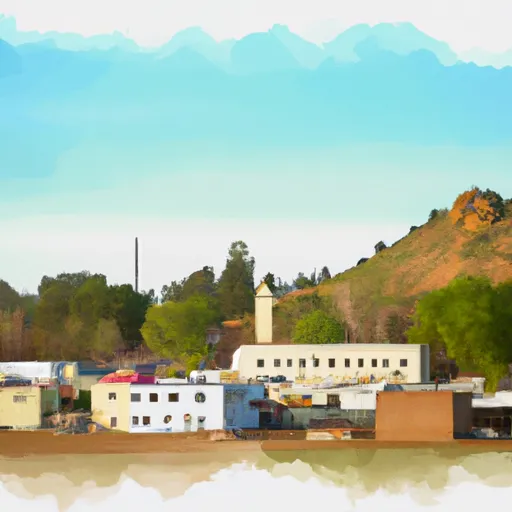-
 Snoflo Premium
Snoflo Premium
Get unlimited access to all our content
With no Ad interruptions! - Start Your Free Trial Login with existing account
Prather
Eden Index
Climate
9.5
•
Recreation
6.2
•
Community
1.4
•
Safeguard
6.3/10

Prather, California is a small unincorporated community located in the Sierra Nevada foothills of Fresno County. The region experiences a Mediterranean climate characterized by hot, dry summers and mild, wet winters. Summers in Prather can see temperatures reaching into the 90s°F (30s°C), while winters are cooler with average highs in the 50s°F (10s°C).
Hydrologically, Prather is part of the San Joaquin River watershed. The area is primarily fed by rainfall and snowmelt from the nearby mountains. The hydrology of Prather is essential for irrigation purposes, supporting agriculture in the region.
Prather offers various outdoor recreation opportunities due to its scenic location. The community is surrounded by stunning natural landscapes, including the Sierra National Forest and the nearby Sierra Nevada Mountains. Outdoor enthusiasts can explore hiking and biking trails, go camping, or indulge in fishing and boating activities in nearby lakes and streams. The area is also known for its wildlife viewing opportunities, including sightings of deer, squirrels, and a variety of bird species.
Overall, Prather, California provides an ideal destination for individuals seeking a pleasant climate, hydrological significance, and a range of outdoor recreational activities amidst breathtaking natural beauty.
What is the Eden Index?
The Snoflo Eden Index serves as a comprehensive rating system for regions, evaluating their desirability through a holistic assessment of climate health, outdoor recreation opportunities, and natural disaster risk, acknowledging the profound impact of these factors on livability and well-being.
Climate Health Indicator (CHI): 9.5
Prather receives approximately
558mm of rain per year,
with humidity levels near 73%
and air temperatures averaging around
17°C.
Prather has a plant hardyness factor of
9, meaning
plants and agriculture in this region tend to thrive here all year round.
By considering the ideal temperature range, reliable water supplies, clean air, and stable seasonal rain or snowpacks, the Climate Health Indicator (CHI) underscores the significance of a healthy climate as the foundation for quality living.
A healthy climate is paramount for ensuring a high quality of life and livability in a region, fostering both physical well-being and environmental harmony. This can be characterized by ideal temperatures, reliable access to water supplies, clean air, and consistent seasonal rain or snowpacks.
Weather Forecast
Streamflow Conditions
San Joaquin
Area Rivers
San Joaquin
Snowpack Depths
San Joaquin
Reservoir Storage Capacity
San Joaquin
Groundwater Levels
Recreational Opportunity Index (ROI): 6.2
The Recreational Opportunity Index (ROI) recognizes the value of outdoor recreational options, such as parks, hiking trails, camping sites, and fishing spots, while acknowledging that climate plays a pivotal role in ensuring the comfort and consistency of these experiences.
Access to outdoor recreational opportunities, encompassing activities such as parks, hiking, camping, and fishing, is crucial for overall well-being, and the climate plays a pivotal role in enabling and enhancing these experiences, ensuring that individuals can engage in nature-based activities comfortably and consistently.
Camping Areas
| Campground | Campsites | Reservations | Toilets | Showers | Elevation |
|---|---|---|---|---|---|
| Smalley Cove | None | 1,034 ft | |||
| Island Park - Pine Flat Lake | 97 | 1,157 ft | |||
| Pine Flat Rec Area | 52 | 586 ft | |||
| Camp Edison | 252 | 5,453 ft | |||
| Redinger | 5 | 1,374 ft | |||
| Millerton Lake State Rec Area | 148 | 613 ft | |||
| Trimmer - Pine Flat Lake | 10 | 938 ft | |||
| Dorabelle | 71 | 5,418 ft | |||
| Choinumni | 36 | 557 ft | |||
| Whisky Falls | 18 | 5,818 ft |
Nearby Ski Areas
Catastrophe Safeguard Index (CSI):
The Catastrophe Safeguard Index (CSI) recognizes that natural disaster risk, encompassing floods, fires, hurricanes, and tornadoes, can drastically affect safety and the overall appeal of an area.
The level of natural disaster risk in a region significantly affects safety and the overall livability, with climate change amplifying these risks by potentially increasing the frequency and intensity of events like floods, fires, hurricanes, and tornadoes, thereby posing substantial challenges to community resilience and well-being.
Community Resilience Indicator (CRI): 1.4
The Community Resilience Indicator (CRI) recognizes that education, healthcare, and socioeconomics are crucial to the well-being of a region. The CRI acknowledges the profound impact of these elements on residents' overall quality of life. By evaluating educational resources, healthcare accessibility, and economic inclusivity, the index captures the essential aspects that contribute to a thriving community, fostering resident satisfaction, equity, and social cohesion.

